page 25
Note: the contents of this page as well as those which precede and follow, must be read as a continuation and/or overlap in order that the continuity about a relationship to/with the dichotomous arrangement of the idea that one could possibly talk seriously about peace from a different perspective as well as the typical dichotomous assignment of Artificial Intelligence (such as the usage of zeros and ones used in computer programming) ... will not be lost (such as war being frequently used to describe an absence of peace and vice-versa). However, if your mind is prone to being distracted by timed or untimed commercialization (such as that seen in various types of American-based television, radio, news media and magazine publishing... not to mention the average classroom which carries over into the everyday workplace), you may be unable to sustain prolonged exposures to divergent ideas about a singular topic without becoming confused, unless the information is provided in a very simplistic manner.
Let's face it, humanity has a lousy definition, accompanying practice, and analysis of peace.
Let's try another approach to assisting some readers with the questions involving the sufficiency of the present definition(s) of peace [as a dichotomy to war or conflict], in that it is a projected anthropomorphism much like Thomas Young's double-split experiment from which is derived the notion that atoms are viewed as a wave or particle, though some have offered the idea of a "wavicle" as a sort of synthesis between the two ideas... thus proposing a third type of conception.
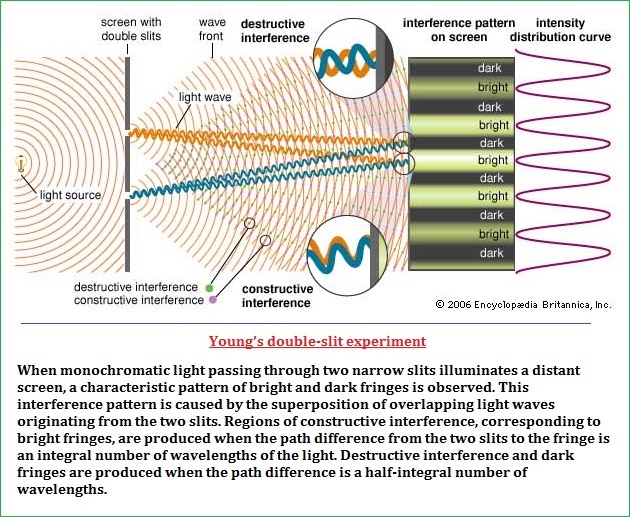
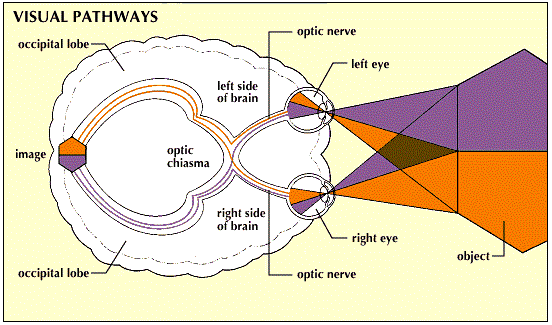
While the double-slit experiment's findings are overlayed with a philosophy describing the usage of the two-slit model that is not seen as a projected image of human stereoscopic vision, its application to the understanding of waves has been useful in the later identification of most light sources being described as incoherent waves in that they have alternating shifts in phase which details a situation in which two (or more) waves can interact (1) in phase, (2) out of phase, or (3) some proportion thereof.
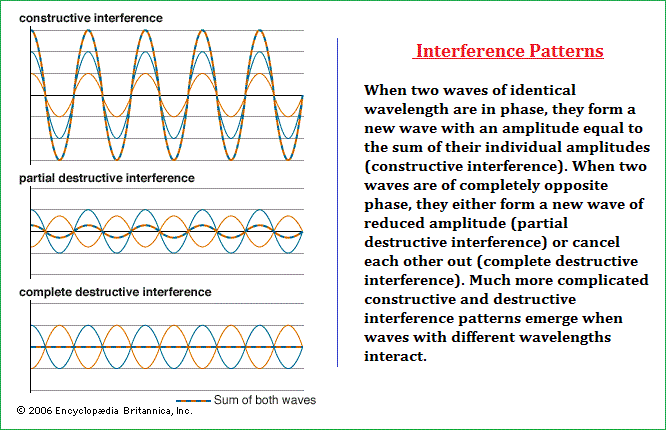
With respect to the present Peace/War (conflict) discussion, the words "peace" and "war" refer to descriptive wave patterns because it is a situation being produced by an incoherent source of influences such as the deteriorating sequences involving human life spans and the deteriorating circumstances of the planet, solar system and galaxy. In short, the "phasing" shifts and humanity has not turned its attention to identifying what is causing the phase shifts which produce war then peace then war then peace, etc..., as if we are seeing a wave pattern such as the ones shown here:
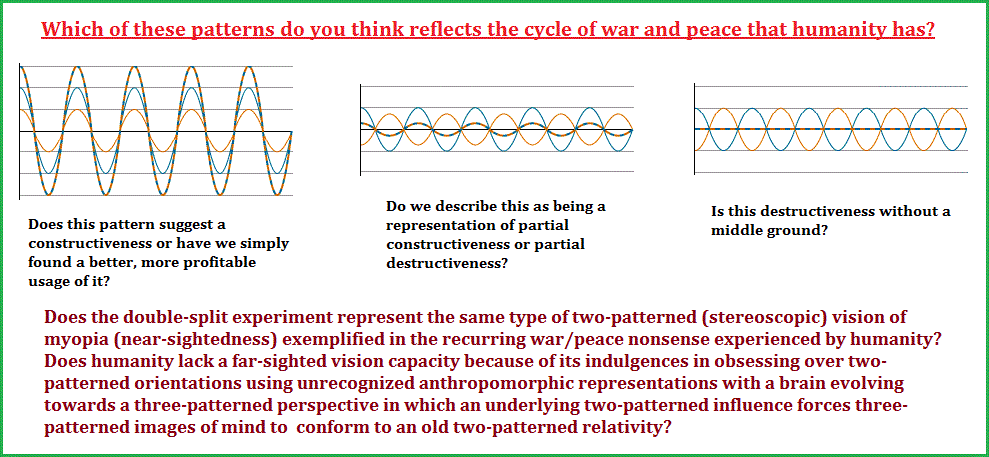
Yet, though the analogy may appeal to some readers, what if it is a lousy model... a distraction, because the cyclical patterns of peace and war are not (independent) waves, are not "particles", but do indeed reflect a type of "wavicle" in that the assumed existing solidification is brought about by a vacuum type of energy which creates a dispersed field of undulations... like a rock dropped into a pool of water whose downward momentum creates a type of suction (vacuum- like a black hole or pupil of the eye which does not emit light and can be thought of as a microcosm of an event in space) around which swirls a collapsing field which "emanates" outward like the concentric rings seen in a pond; and described as "shells" of energy placement in discussions of atomic particles?
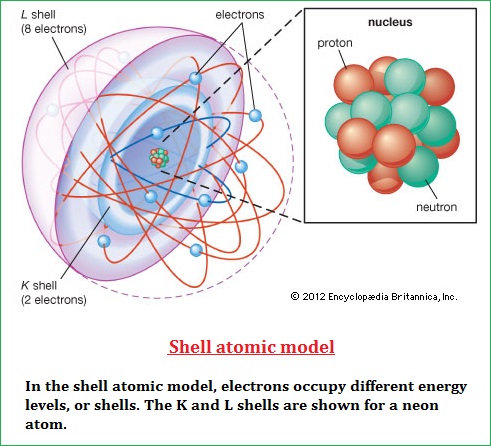
|
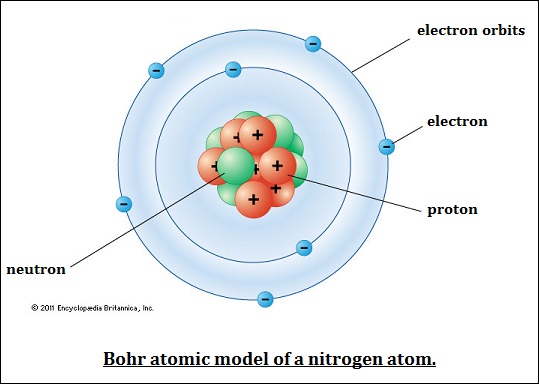
|
Let us suggest that, due to the presence of multifarious examples of "threes", that the two-slit model is just another example of the old perspective of the world viewed in terms of various dichotomies (heaven/hell, yes/no, right/wrong, man/woman, good/evil, etc...); from which the wave/particle duality arose as a feature when looking at the world through the eyes of a physicist whose brain retains the evolutionary-based developmental progress of a "two" orientation; which is being subjected to the perspective of those whose brains have inched closer to a three-patterned world view. Whereas we humans designate differences between light (described as a wave) and matter (described as a particle); we nonetheless rely on a stereoscopic-like two slit experiment to answer a two-patterned problem!!! Analogously, it's the presentation of a problem applied to a context in which the parameters are defined as an acceptable unbiased referee... when it actually is biased due to a construction reflecting an anthropomorphic design. And yet, when this option is taken into consideration by the very same sorts of minds which created the experiment in the first place, the old two-split experiment become rejected and is replaced by yet another variation of anthropomorphism called "quantum mechanics":
|
The quantum mechanics embodied in the 1926-27 formulation is non-relativistic—that is, it applies only to particles whose speeds are significantly less than the speed of light. The quantum mechanical description of light was not fully realized until the late 1940s. However, light and matter share a common central feature—a complementary relation between wave and particle aspects—that can be illustrated without resorting to the formalisms of relativistic quantum mechanics. Wave-particle dualityThe same interference pattern demonstrated in Young's double-slit experiment is produced when a beam of matter, such as electrons, impinges on a double-slit apparatus. Concentrating on light, the interference pattern clearly demonstrates its wave properties. But what of its particle properties? Can an individual photon be followed through the two-slit apparatus, and if so, what is the origin of the resulting interference pattern? The superposition of two waves, one passing through each slit, produces the pattern in Young's apparatus. Yet, if light is considered a collection of particle-like photons, each can pass only through one slit or the other. Soon after Einstein's photon hypothesis in 1905, it was suggested that the two-slit interference pattern might be caused by the interaction of photons that passed through different slits. This interpretation was ruled out in 1909 when the English physicist Geoffrey Taylor reported a diffraction pattern in the shadow of a needle recorded on a photographic plate exposed to a very weak light source, weak enough that only one photon could be present in the apparatus at any one time. Photons were not interfering with one another; each photon was contributing to the diffraction pattern on its own. In modern versions of this two-slit interference experiment, the photographic plate is replaced with a detector that is capable of recording the arrival of individual photons. Each photon arrives whole and intact at one point on the detector. It is impossible to predict the arrival position of any one photon, but the cumulative effect of many independent photon impacts on the detector results in the gradual buildup of an interference pattern. The magnitude of the classical interference pattern at any one point is therefore a measure of the probability of any one photon's arriving at that point. The interpretation of this seemingly paradoxical behaviour (shared by light and matter), which is in fact predicted by the laws of quantum mechanics, has been debated by the scientific community since its discovery more than 100 years ago. In a wholly unexpected fashion, quantum mechanics resolved the long wave-particle debate over the nature of light by rejecting both models. The behaviour of light cannot be fully accounted for by a classical wave model or by a classical particle model. These pictures are useful in their respective regimes, but ultimately they are approximate, complementary descriptions of an underlying reality that is described quantum mechanically. Glen Stark: Professor of Physics, Wellesley College, Massachusetts, U.S.Source: "light." Encycloædia Britannica Ultimate Reference Suite, 2013. |
If one argues that the old wave/particle, light/matter dualities have been resolved by introducing a third perspective, then this same idea may hold for solving the peace/war dichotomy as well... since so many of us view the dynamics of human society as a large quantum mechanical expression. Then again, because we are an adaptive biological organism that appears to be inclined to develop a thinking pattern which uses a system of "adjustable rationalizations" as a means of maintaining a relatively stable sense of equilibrium in an environment proceeding along an incrementally decaying course; the so-called "quantum mechanics" answer may be little more than an adjusted rationalization... thus describing the position of our biological sense of being in an environment whose end-time has already been calculated by physiological/genetic sensitivities that we are not conscious of.
It is rather interesting to point out that while we can denote the usage of single-slit experiment to contrast that with a double-slit experiment, no "more abundant" slit versions are likewise routinely mentioned as an exercise of historical referencing, suggesting the presence of a limitation in our thinking which is excused by various explanations of arriving at a redundancy. In other words, if we were to use a three, four, five, etc., slit experiment, we might well encounter the "reasons" for not doing so based on just more of the same interference patterns being overlapped. Be this as it may, it nonetheless describes the presence of a cognitive limitation which may be that affecting the peace/war profile of thinking. In other words, humans are in a rut because their life style of thinking is keeping them in a rut.
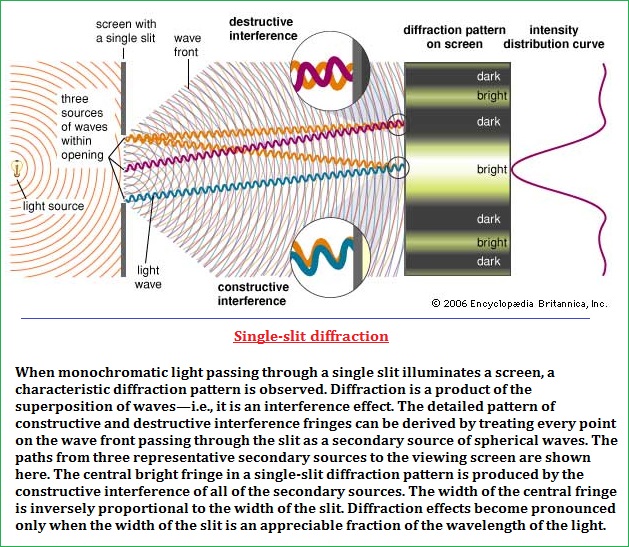
If we view the "light/dark" bands as a metaphor for the peace/war dichotomy, some might want to use the comparison to suggest that the prevailing seemingly never-ending cycle of war and peace (conflict and peace) are a fact of life... are a "law" of nature without having listened to what has repeatedly been described about human thinking following a course of evolutionary growth in a decaying environment; in which the evolutionary development must adopt adjustable rationalizations in an effort to maintain some semblance of equilibrium all the while it is headed towards extinction... so long as humanity stays on this planet in this solar system. The recurring cycle of war and peace is a tell-tale sign of evolutionary attempts to grow in an environment that imposes limitations... which are restrictions that are going to increase as resources continue to decline and will decline faster the more people are born. War and peace are symbols of the underlying growth/decadence situation occurring with humans on the planet Earth.
The dichotomous perspective of the "electro-magnetic" reality related to light as yet another perception of a presumed existing dual pattern, should be viewed. Let's take a look at a short excerpt from the Britannica:
Light as electromagnetic radiation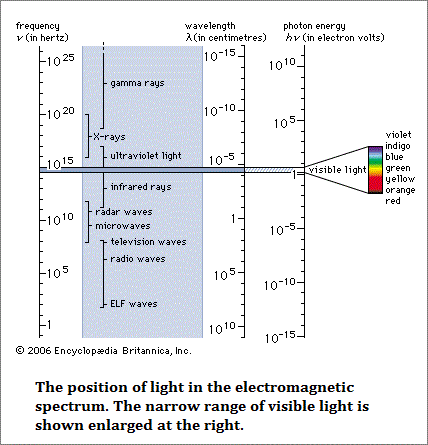
In spite of theoretical and experimental advances in the first half of the 19th century that established the wave properties of light, the nature of light was not yet revealed—the identity of the wave oscillations remained a mystery. This situation dramatically changed in the 1860s when the Scottish physicist James Clerk Maxwell, in a watershed theoretical treatment, unified the fields of electricity, magnetism, and optics. In his formulation of electromagnetism, Maxwell described light as a propagating wave of electric and magnetic fields. More generally, he predicted the existence of electromagnetic radiation: coupled electric and magnetic fields traveling as waves at a speed equal to the known speed of light. In 1888 German physicist Heinrich Hertz succeeded in demonstrating the existence of long-wavelength electromagnetic waves and showed that their properties are consistent with those of the shorter-wavelength visible light. Electric and magnetic fieldsThe subjects of electricity and magnetism were well developed by the time Maxwell began his synthesizing work. English physician William Gilbert initiated the careful study of magnetic phenomena in the late 16th century. In the late 1700s an understanding of electric phenomena was pioneered by Benjamin Franklin, Charles-Augustin de Coulomb, and others. Siméon-Denis Poisson, Pierre-Simon Laplace, and Carl Friedrich Gauss developed powerful mathematical descriptions of electrostatics and magnetostatics that stand to the present time. The first connection between electric and magnetic effects was discovered by Danish physicist Hans Christian Ørsted in 1820 when he found that electric currents produce magnetic forces. Soon after, French physicist André-Marie Ampère developed a mathematical formulation (Ampère's law) relating currents to magnetic effects. In 1831 the great English experimentalist Michael Faraday discovered electromagnetic induction, in which a moving magnet (more generally, a changing magnetic flux) induces an electric current in a conducting circuit. Faraday's conception of electric and magnetic effects laid the groundwork for Maxwell's equations. Faraday visualized electric charges as producing fields that extend through space and transmit electric and magnetic forces to other distant charges. Glen Stark: Professor of Physics, Wellesley College, Massachusetts, U.S.Source: "light." Encycloædia Britannica Ultimate Reference Suite, 2013. |
By reviewing the above instances of displayed dualities (wave/particle, light/matter, electricity/magnetism); one might be inclined to think that a perception focused primarily on the usage of a two-patterned ideology would serve them well, so long as they permitted the exercise of allowing considerations of three-patterned ideas when it was the prevailing mood of a given social environment in which numerous or socially significant others were edging closer to a determined reliance on pattern-of-three thinking. For example, if we say that the duality of the peace/war model of conceptualization is part of an older system of mentality still in vogue as a dominant orientation in some instances of human activity, a former strong reliance on viewing the world in dualities will attempt to superimpose itself on a budding developmental trend to see the world in any other pattern, such as a pattern-of-three for instance. A pattern-of-two orientation has staked a claim in human consciousness and won't let the territory go without a fight. A pattern-of-three orientation would be like a farmer trying to mark out a piece of land dominated by sheep, cattle or horse ranches. If the farmer is not seen as a threat and provides some measure of value, they might be allowed, like some three-(or other patterned) perspective. However, if numerous farmers or numerous examples of patterns-of-three move in the area once dominated by patterns-of-two, they might be perceived as a threat, with an ensuing battle forthcoming.
No doubt that a similar type of event took place when the brain of humanity developed towards a mammalian two-patterned world-view away from its dominant single-(minded) "patterned-ness" existing with its ancient reptilian ancestry... though we must admit that a catalogue of one-patterned examples would have to rely on our present perspectives of what we would think a reptilian "one-patterned-ness" world view would have been like, since it is unlikely that we will come across some "encyclopedia reptilica" discovered in some reptilian lair. Although such (a presumed) single-mindedness exists today in a (supposed) much diminished form, and was more pronounced amongst humans in centuries past, many of the single-patterned world-view "ideas" (impulses) has been incorporated into two-patterned formulations now caught in the middle of a growing base of three-patterned perceptions.
In an attempt to conceptualize what a "one-patterned perspective" might be, we would have to try to think in terms of a creature whose brain primarily functioned as a means of sustaining physiological processes for survival. The "eat, or be eaten" type of existence. And while this is a pattern-of-two from our perspective, in the world of many life forms, the singular impulse to live is that which is predominant. It is that which soldiers are forced to evoke because of the idiots in command structures whose perspective of the world relies on a dominant two-patterned light and dark or white and black spectrum of reality. And though some readers may want to consider that the cyclicity of war and peace will continue until the human species evolves away from a dominant two-patterned perspective of reality, this may not be the case if those with a dominant two-patterned world-view brain remain the dominant species being reborn and protected by business, government and religious systems whose structures are architectured by a blueprint based primarily on a two-patterned scheme of rationality.
Along with the above dual-laden references (wave/particle, light/matter, electricity/magnetism), a colleague has reminded us of the situation involving the dichotomies of "Space and Matter" (related to Relativity), and "Matter and Energy" (related to Quantum Mechanics). Stated in this juxtaposed framework, it can be recognized that there exists yet another duality which is in need of a unification to provide what has been referred to as a Grand Unified Theory [Gut] (of Theory of Everything) [Toe]; as abbreviations of unrealized anthropomorphisms. In other words, as they are presently viewed in their two-patterned configuration, the theories have not as yet been identified with any mathematically-based unification. This may be due to the same problem we are encountering with when trying to solve the duality problem of "peace and war".
By cataloguing different ideas into fundamental patterns (patterns-of-one, patterns-of-two, patterns-of-three, etc.,) we come to understand that their is a limited quantity to the type and kind of patterns we use. It's not that other types and kinds do not exist, it's just that the human species is subjected to conditions which make such usage a quixotic exercise when a conservation of energy appears to be all that is needed in an environment where a reduction in resources is taking place and the planet/planetary system is decaying and doesn't require life forms to have a perception of living beyond the capacities being presented. Developing a third set of laws to explain all theories in physics is of little value to a species that is headed along a course of extinction by adjusting its beliefs (rationalizations) according to the requirements for sustaining a relative equilibrium as population increases and resources decrease; coupled with:
- Earth's rotation continues to slow (thus affecting the electro-magnetic dynamo).
- The Moon is receding (thus affecting the "washing machine" effect of the tides).
- The Sun is burning out and will eventually expand (how much is debated).
It is not certain whether the evolutionary trend of humanity will continue to develop if stringent methods of conservation will be imposed by nature, or human institutions as a method for attempting to deal with decreasing resources and overall environmental deteriorations. In other words, though we have catalogued what appears to be a developmentally occurring anatomical, behavioral and mental trend towards three-patterned "expressions" within the respective parameters of activity, a fully developed "three-patterned" perspective may not be possible because the necessary nutrients for optimal growth are dwindling fast... if they even ever existed. While some aberration of growth may no less be born, like a plant or animal having not received the necessary nutrients at critical stages of development which results in an immature, dysfunctional, or deformed representation; even if we were to develop some semblance of a theory to unify all physic's views, it too may be but the result of rationalizing our time and place in history... with respect to the level of deteriorations we are presently subjected to.
Let us emphasize the term "conservation" since it plays a large role in physics as is described by referring to a "conservation of energy". And because we can recognize what the result effects of a deterioration might have, the notion of reintroducing some sort of previous normalization to the process may come to mind, with respect to those wanting to know what a "mature" three-patterned perspective might reveal. However, as is noted in language development, for example, a critical period for language development has been recognized by those attempting to teach feral children to use conventional human language (those children who had been found in the wild living away from humans and later introduced to human socialization). No matter how rich the language environment was for such children, only a rudimentary level of language appears to have been acquired. And the analogous point to be made is that the same thing may occur on the quantum level. There may be an unobserved level of deterioration taking place that is not being regarded as a variable in the equation. What we have is an accurate description of an inaccurate circumstance, and we fool ourselves into thinking we have arrived at some Grand Unified Theory which is describing a point in time of an overall deterioration taking place.
Let's take a look at an excerpt from a Britannica article on Electromagnetic radiation related to the present ideas:
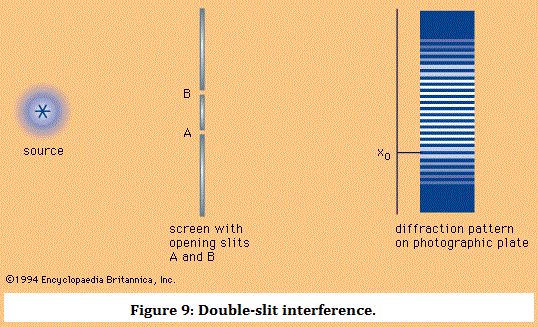
The interference pattern that results when a radiation front hits two slits in an opaque screen is often cited to explain the conceptual difficulty of the wave–particle duality. Consider an opaque screen with two openings A and B, called double slit, and a photographic plate or a projection screen, as shown in Figure 9. A parallel wave with a wavelength λ passing through the double slit will produce the intensity pattern on the plate or screen as shown at the right of the figure. The intensity is greatest at the centre. It falls to zero at all locations Xo, where the distances to the openings A and B differ by odd-number multiples of a half wavelength, as, for instance, λ/2, 3λ/2, and 5λ/2. The condition for such destructive interference is the same as for Michelson's interferometer illustrated in Figure 4. Whereas a half-transparent mirror in Figure 4 divides the amplitude of each wave train in half, the division in Figure 9 through openings A and B is spatial. The latter is called division of wave front. Constructive interference or intensity maxima are observed on the screen at all positions whose distances from A and B differ by zero or an integer multiple of λ. This is the wave interpretation of the observed double-slit interference pattern. 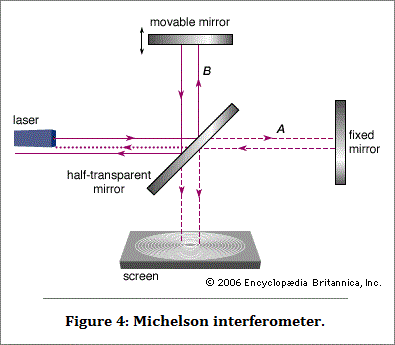
The description of photons is necessarily different because a particle can obviously only pass through opening A or alternatively through opening B. Yet, no interference pattern is observed when either A or B is closed. Both A and B must be open simultaneously. It was thought for a time that one photon passing through A might interfere with another photon passing through B. That possibility was ruled out after the British physicist Geoffrey Taylor demonstrated in 1909 that the same interference pattern can be recorded on a photographic plate even when the light intensity is so feeble that only one photon is present in the apparatus at any one time. Another attempt to understand the dual nature of electromagnetic radiation was to identify the photon with a wave train whose length is equal to its coherence length cτ, where τ is the coherence time, or the lifetime of an atomic transition from a higher to a lower internal atomic energy state, and c is the light velocity. This is the same as envisioning the photon to be an elongated wave packet, or “needle radiation.” Again, the term “photon” had a different meaning for different scientists, and wave nature and quantum structure remained incompatible. It was time to find a theory of electromagnetic radiation that would fuse the wave theory and the particle theory. Such a fusion was accomplished by quantum electrodynamics (QED). Quantum electrodynamicsAmong the most convincing phenomena that demonstrate the quantum nature of light are the following. As the intensity of light is dimmed further and further, one can see individual quanta being registered in light detectors. If the eyes were about 10 times more sensitive, one would perceive the individual light pulses of fainter and fainter light sources as fewer and fewer flashes of equal intensity. Moreover, a movie has been made of the buildup of a two-slit interference pattern by individual photons, such as shown in Figure 9 . Photons are particles, but they behave differently from ordinary particles like billiard balls. The rules of their behaviour and their interaction with electrons and other charged particles, as well as the interactions of charged particles with one another, constitute QED. Photons are created by perturbances in the motions of electrons and other charged particles; and, in reverse, photons can disappear and thereby create a pair of oppositely charged particles, usually a particle and its antiparticle (e.g., an electron and a positron). A description of this intimate interaction between charged particles and electromagnetic radiation requires a theory that includes both quantum mechanics and special relativity. The foundations of such a theory, known as relativistic quantum mechanics, were laid beginning in 1929 by Paul A.M. Dirac, Heisenberg, and Wolfgang Pauli. The discussion that follows explains in brief the principal conceptual elements of QED. Many phenomena in nature do not depend on the reference scale of scientific measurements. For instance, in electromagnetism the difference in electrical potentials is relevant but not its absolute magnitude. During the 1920s, even before the emergence of quantum mechanics, the German physicist Hermann Weyl discussed the problem of constructing physical theories that are independent of certain reference bases or absolute magnitudes of certain parameters not only locally but everywhere in space. He called this property “Eich Invarianz,” which is the conceptual origin of the term “gauge invariance” that plays a crucial role in all modern quantum field theories. In quantum mechanics all observable quantities are calculated from so-called wave functions, which are complex mathematical functions that include a phase factor. The absolute magnitude of this phase is irrelevant for the observable quantities calculated from these wave functions; hence, the theory describing, for example, the motion of an electron should be the same when the phase of its wave function is changed everywhere in space. This requirement of phase invariance, or gauge invariance, is equivalent to demanding that the total charge is conserved and does not disappear in physical processes or interactions. Experimentally one does indeed observe that charge is conserved in nature. It turns out that a relativistic quantum theory of charged particles can be made gauge invariant if the interaction is mediated by a massless and chargeless entity which has all the properties of photons. Coulomb's law of the force between charged particles can be derived from this theory, and the photon can be viewed as a “messenger” particle that conveys the electromagnetic force between charged particles of matter. In this theory, Maxwell's equations for electric and magnetic fields are quantized. The range of a force produced by a particle with nonzero mass is its Compton wavelength h/mc, which for electrons is about 2 × 10-10 centimetre. Since this length is large compared with distances over which stronger nuclear forces act, QED is a very precise theory for electrons. Despite the conceptual elegance of the QED theory, it proved difficult to calculate the outcome of specific physical situations through its application. Richard P. Feynman and, independently, Julian S. Schwinger and Freeman Dyson of the United States and Tomonaga Shin'ichiro— of Japan showed in 1948 that one could calculate the effects of the interactions as a power series in which the coupling constant is called the fine structure constant and has a value close to 1/137. A serious practical difficulty arose when each term in the series, which had to be summed to obtain the value of an observed quantity, turned out to be infinitely large. In short, the results of the calculations were meaningless. It was eventually found, however, that these divergences could be avoided by introducing “renormalized” couplings and particle masses, an idea conceived by the Dutch physicist Hendrik A. Kramers. Just as a ship moving through water has an enhanced mass due to the fluid that it drags along, so will an electron dragging along and interacting with its own field have a different mass and charge than it would without it. By adding appropriate electromagnetic components to the bare mass and charge—that is, by using renormalized quantities—the disturbing infinities could be removed from the theory. Using this method of renormalization and the perturbation theory, Feynman developed an elegant form for calculating the likelihood of observing processes that are related to the interaction of electromagnetic radiation with matter to any desired degree of accuracy. For example, the passage of an electron or a photon through the double slit illustrated in Figure 9 will, in this QED formalism, produce the observed interference pattern on a photographic plate because of the superposition of all the possible paths these particles can take through the slits. The success of unifying electricity, magnetism, and light into one theory of electromagnetism and then with the interaction of charged particles into the theory of quantum electrodynamics suggests the possibility of understanding all the forces in nature (gravitational, electromagnetic, weak nuclear, and strong nuclear) as manifestations of a grand unified theory (GUT). The first step in this direction was taken during the 1960s by Abdus Salam, Steven Weinberg, and Sheldon Glashow, who formulated the electroweak theory, which combines the electromagnetic force and the weak nuclear force. This theory predicted that the weak nuclear force is transmitted between particles of matter by three messenger particles designated W+, W-, and Z, much in the way that the electromagnetic force is conveyed by photons. The three new particles were discovered in 1983 during experiments at the European Organization for Nuclear Research (CERN), a large accelerator laboratory near Geneva. This triumph for the electroweak theory represented another stepping stone toward a deeper understanding of the forces and interactions that yield the multitude of physical phenomena in the universe. Hellmut Fritzsche: Louis Block Professor of Physics, University of Chicago. Coauthor and editor of Advances in Disordered Semiconductors (2 vol.).Source: "Electromagnetic Radiation." Encyclopædia Britannica Ultimate Reference Suite, 2013. |
With the search for a Third (unifying) physics law and the idea of three "messenger" particles, one might think they are dealing with another biological representation such as the existence of a triplet code (law) existing with DNA/RNA and the existence of three stop codons and one start codon... not to mention a messenger, ribosomal, and transfer type of RNA. (mRNA, rRNA, tRNA). It is rather interesting that there are similar basic patterns between genetics and physics, but that the experts in these respective fields might well rush to point out differences like so many experts of religious ideas do... who don't want to find a unifying principal to all religions, or all economic theories, or all social governing ideas, etc...
And if we should think to describe a presumptive Grand Unified Theory, then what? What good is it if humanity is stuck on a planet, solar system or galaxy heading along a course of extinction? What will happen to all the presumed great achievements of humanity if there is no humanity to benefit from it? Put it in safe keeping for some extra-terrestrial who may view human archives as primitive as the scratch marks of some ancient people that anthropologists encounter from time to time today? What's the point if humanity should live for another billion years only to perish because it's too stupid to remove itself from a decaying planet and solar system? What's the point of amassing a huge knowledge base if some future sentient species views all of it as the nonsensical gibberish of a species that altered its beliefs according to the level and type of decadence it was incrementally experiencing? All of which brings us back to a two-patterned, single-minded myopic vision of selfishness concerned with the here and now. Just like each war, and each period of presumed peace... as if they are to be viewed and experienced as separate and individualized realities that both the United Nations and Nobel Peace prize committee focus on because they define, analyze and practice peace in a lousy way.
Date of Origination: Thursday, 19-Jan-2017... 03:50 AM
Date of initial posting: Saturday, 28-Jan-2017... 12:52 PM
Updated posting: Saturday, 31-March-2018... 12:00 PM